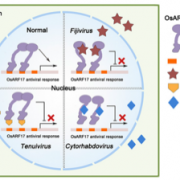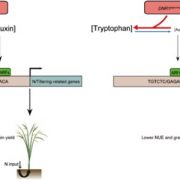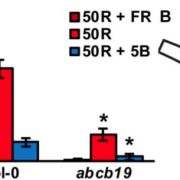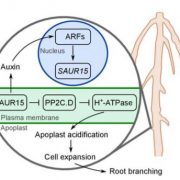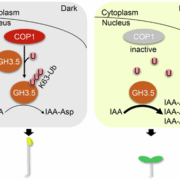Auxin receptor OsTIR1 mediates auxin signaling during seed filling in rice
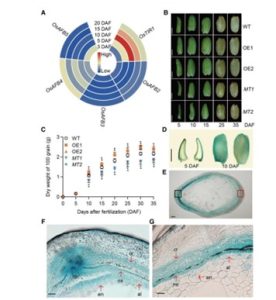 Throughout the world, cereal endosperm is a major source of food. However, little is known about the molecular mechanisms underlying the import of sugar into the endosperm of rice plants (Oryza sativa) and how these pathways relate to auxin signaling. In this paper, Wu et al. investigate the role of auxin receptor OsTIR1 (Oryza sativa transport inhibitor response 1) in rice seed filling and its relationship with sugar import into the endosperm. The authors found that OsTIR1 mediates sugar import into endosperm via the auxin signaling component OsARF25 interacting with the sugar transporter OsSWEET11. Mutations in OsTIR1 repressed starch accumulation and reduced grain yield and quality, while overexpression of the gene improved starch accumulation and grain yield and quality. OsTIR1 has been shown to be highly expressed in the endosperm, nucellar projection, nucellar epidermis, aleurone layer cells, and ovular vascular trace, suggesting a possible route for sugar to enter the endosperm. The main auxin signaling element implicated in rice grain filling is known to be OsAR25, which interacts with the sugar transporter OsSWEET11. It has been hypothesized that OsIAA1 interacts directly with OsARF25 to influence OsTIR1-regulated endosperm development. Compared to wild-type plants, the overexpression of OsTIR1 improved grain quality and boosted grain output by 32% to 52% over the course of three years of field trials. Additionally, the authors observed that lower grain size and grain yield in tir1 mutant lines might also result from slender stems and less adventitious roots in tir1 mutant lines relative to wild-type plants. (Summary by Muhammad Aamir Khan @MAKNature1998) Plant Physiol. 10.1093/plphys/kiae013
Throughout the world, cereal endosperm is a major source of food. However, little is known about the molecular mechanisms underlying the import of sugar into the endosperm of rice plants (Oryza sativa) and how these pathways relate to auxin signaling. In this paper, Wu et al. investigate the role of auxin receptor OsTIR1 (Oryza sativa transport inhibitor response 1) in rice seed filling and its relationship with sugar import into the endosperm. The authors found that OsTIR1 mediates sugar import into endosperm via the auxin signaling component OsARF25 interacting with the sugar transporter OsSWEET11. Mutations in OsTIR1 repressed starch accumulation and reduced grain yield and quality, while overexpression of the gene improved starch accumulation and grain yield and quality. OsTIR1 has been shown to be highly expressed in the endosperm, nucellar projection, nucellar epidermis, aleurone layer cells, and ovular vascular trace, suggesting a possible route for sugar to enter the endosperm. The main auxin signaling element implicated in rice grain filling is known to be OsAR25, which interacts with the sugar transporter OsSWEET11. It has been hypothesized that OsIAA1 interacts directly with OsARF25 to influence OsTIR1-regulated endosperm development. Compared to wild-type plants, the overexpression of OsTIR1 improved grain quality and boosted grain output by 32% to 52% over the course of three years of field trials. Additionally, the authors observed that lower grain size and grain yield in tir1 mutant lines might also result from slender stems and less adventitious roots in tir1 mutant lines relative to wild-type plants. (Summary by Muhammad Aamir Khan @MAKNature1998) Plant Physiol. 10.1093/plphys/kiae013


